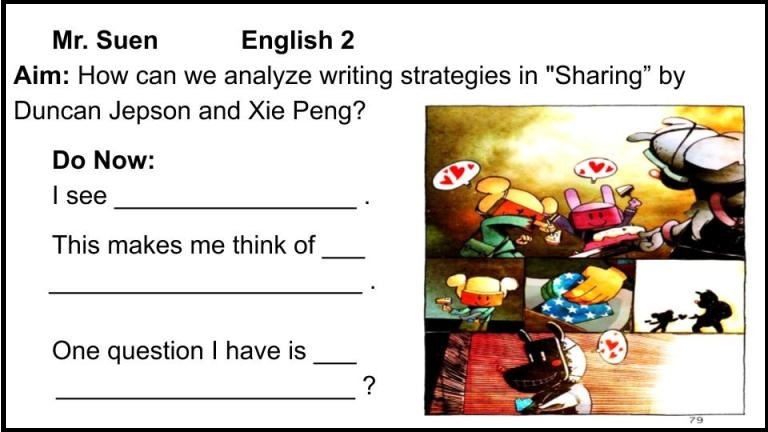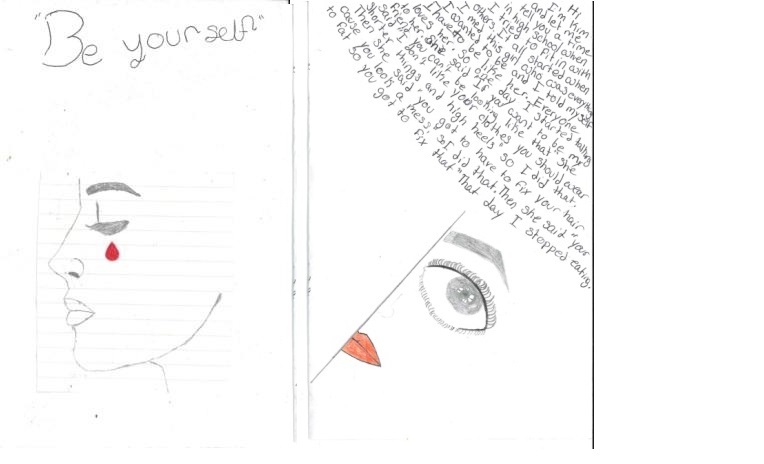Educators' Voices: Bringing Global Graphic Fiction to English Language Learners
Posted on June 12, 2019

No one watching Leighton Suen confidently leading a discussion of the Chinese graphic fiction story "Sharing" in the classroom would guess that this was the very first work in that genre he had ever taught, or that the path that led him to become a teacher began with an experience of powerlessness. But it is this very quality---this tendency to respond to challenges with hard work and initiative---that has shaped Leighton's educational career, and which he models for his students as they strive to learn English.
Leighton teaches 9th grade English and English as a New Language to immigrant students at FDR, a large public high school in Brooklyn's Borough Park neighborhood. These students are highly diverse, hailing more than 75 different countries and speaking more than 50 languages at home. As Leighton put it when he reached out to Words Without Borders: "If you're looking to see these stories in diverse populations, FDR can be ground zero."
Students are also diverse in their levels of English knowledge, which can be somewhat of a challenge in the classroom. To make informational resources accessible to all his students, Leighton often creates simple-English versions of interesting newspaper articles; to support their writing, he collaborates with other teachers to develop sentence stems that help students express complex ideas in English.
Until this year, the one resource Leighton had trouble finding or producing was literature---that is, age-appropriate, engaging, culturally responsive literature. "I don't want [students] to think that the only writers worth reading are British and American," he says. "I want them to see themselves in literature. Often, immigrants are discriminated against, and if they can see that their languages and cultures are valued, they might feel better about themselves, and do better in class."
Leighton contacted Words Without Borders after seeing a call for piloting educators online. He looked through the website, and was excited by the offerings, especially "The Stone Guest," a contemporary story translated from Uzbek. (Several of his students are from Uzbekistan.) This year, he collaborated with Words Without Borders to develop a unit of study around "Sharing."
His path to teaching English began in college, when he was assigned to fieldwork at a school with two new students from China---the only Chinese immigrants at the school. Leighton wanted to help the boys, but, lacking classroom authority or much knowledge of effective strategies, he found there was little he could do. He decided to address those gaps with a master's degree in education, which he obtained from Columbia University's Teachers College several years later.
"Sharing" with ELLs

As they read "Sharing," a complex story that addresses urban alienation and consumerism, Leighton's Chinese-speaking students draw on their knowledge of Chinese culture and history, and his other students benefit from their expertise. (Drawing on students' cultural knowledge also reinforces that home cultures are both valuable and valued in school.) With daily assignments asking them to interpret images and text, all of the students learn how to leverage both visual and textual language to understand the story.
Students work in groups to create posters analyzing symbols within the story. They also make personal connections to the imagery; of an urban landscape, one student writes:
Reminds me of when I first came to the city. I feel alone.
Students' culminating projects including analyses of the symbolism in "Sharing," as well as more personal responses, many of which connected the students' own stories of arrival in New York with that of the central character in "Sharing": "At school, I was like a mute," one essay begins. But then, the essay goes on to explain, a certain teacher helped her overcome her shyness, learn English, and make a successful presentation to the class.
Interested in doing something similar in your own class? The links below will show you how.
- Read "Sharing" on WWB Campus
- Review materials for teaching "Sharing" produced by Leighton and his colleagues: lesson plans, slides, simple-English versions of informational texts, and sentence stems for essays (created by Ms. Yorra, Ms. Emile, and Mr. Suen.)
- See selected student projects from Leighton's class. The students hail from Russia, Haiti, China, and Venezuela. (Reproduction or distribution of any FDR student projects without explicit permission is prohibited.)

If you'd be interested in having your classroom profiled for the WWB Campus blog, please get in touch!



